CORE, the leading CTU caucus, makes nominations for the 2013 union elections.... Lewis, Sharkey, Brunson and Mayle -- and CORE -- are running for second term on May 17... Nearly 200 candidates will be on the May 17 ballots from CORE
The Caucus Of Rank and file Educators (CORE) has nominated its candidates for the upcoming election in the Chicago Teachers Union. At a meeting held at Chicago's Letter Carriers union hall on January 28, 2013, more than 100 members of the caucus met to nominate Karen Lewis, Jesse Sharkey, Kristine Mayle and Michael Bruson to run for a second term to lead the union for another three years following the May 17, 2013 union election.
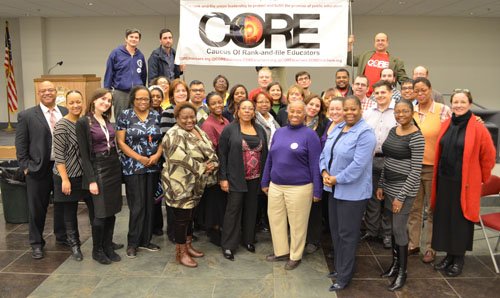 Most of the candidates for executive board seats in the upcoming Chicago Teachers Union election (scheduled for May 17) stood for a photograph at the CORE meeting at Letter Carriers hall on Janaury 28, 2013. The meeting of more than 100 union activists nominated the incumbent four officers for another three-year term. The officers who have led the union since July 1, 2010 are Karen Lewis (President), Jesse Sharkey (Vice President), Michael Brunson (Recording Secretary), and Kristine Mayle (Financial Secretary). Busy on other union business, the president and vice president were not at the meeting but accepted the nomination. Above, the majority of those nominated for executive board seats posed for a CORE photograph. Substance photo by Nate Goldbaum. The members of the caucus also voted to slate 35 additional candidates for seats on the Chicago Teachers Union executive board. Under the structure of the CTU, each group represented by the union elects "functional vice presidents" so that the group is represented on the union's executive board, which meets monthly before each meeting of the House of Delegates. The delegates, who represent every school and all of the non school based groups in the union, are elected every two years at their schools or by those they represent. (Disclosure: this reporter is one of 36 delegates representing retired CTU teachers).
Most of the candidates for executive board seats in the upcoming Chicago Teachers Union election (scheduled for May 17) stood for a photograph at the CORE meeting at Letter Carriers hall on Janaury 28, 2013. The meeting of more than 100 union activists nominated the incumbent four officers for another three-year term. The officers who have led the union since July 1, 2010 are Karen Lewis (President), Jesse Sharkey (Vice President), Michael Brunson (Recording Secretary), and Kristine Mayle (Financial Secretary). Busy on other union business, the president and vice president were not at the meeting but accepted the nomination. Above, the majority of those nominated for executive board seats posed for a CORE photograph. Substance photo by Nate Goldbaum. The members of the caucus also voted to slate 35 additional candidates for seats on the Chicago Teachers Union executive board. Under the structure of the CTU, each group represented by the union elects "functional vice presidents" so that the group is represented on the union's executive board, which meets monthly before each meeting of the House of Delegates. The delegates, who represent every school and all of the non school based groups in the union, are elected every two years at their schools or by those they represent. (Disclosure: this reporter is one of 36 delegates representing retired CTU teachers).
The slating recommendations were presented by Carol Caref, a high school teacher who went on leave to work as director of research for the CTU after the CORE slate won the 2010 election. Caref chaired a committee that included a half dozen members of CORE, who screened candidates who asked to be slated for the various offices. The members of the committee were thanked for their work, which was time consuming and complex. Caref announced that there were no candidates who asked to oppose the four incumbent officers, all of whom said they wanted to run for re-election. No one was nominated from the floor at the meeting either.
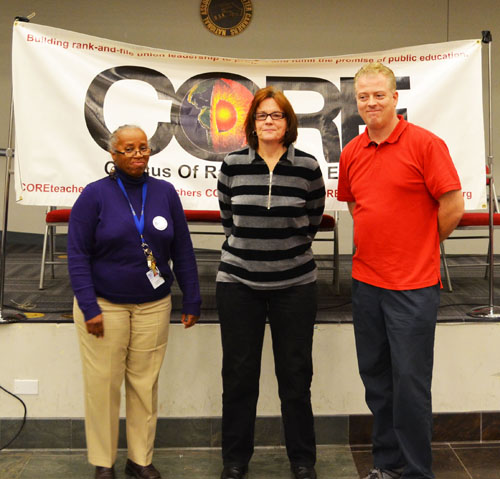 The CORE candidates for Area Vice President are: Patricia Boughton, Sue Garza, and Jim Cavallero. Substance photo by George N. Schmidt. Only two of the four top candidates were present at the meeting, an example, CORE leaders were told, of the fact that the CTU's officers work late every day. Both President Karen Lewis and Vice President Jesse Sharkey were busy with other union commitments, and some of those at the meeting had to leave early because of political and community activities around Chicago. Recording Secretary Micheal Brunson and Financial Secretary Kristine Mayle were present and thanked the organization for its vote of confidence in selecting them for a second term leading the third largest K-12 union local in the American Federation of Teachers.
The CORE candidates for Area Vice President are: Patricia Boughton, Sue Garza, and Jim Cavallero. Substance photo by George N. Schmidt. Only two of the four top candidates were present at the meeting, an example, CORE leaders were told, of the fact that the CTU's officers work late every day. Both President Karen Lewis and Vice President Jesse Sharkey were busy with other union commitments, and some of those at the meeting had to leave early because of political and community activities around Chicago. Recording Secretary Micheal Brunson and Financial Secretary Kristine Mayle were present and thanked the organization for its vote of confidence in selecting them for a second term leading the third largest K-12 union local in the American Federation of Teachers.
As the recommended candidates from each of the functional groups were introduced, they came to the front of the meeting and spoke if they wanted to. In addition to those representing the functional groups, the union also elects three "Area Vice Presidents" and six trustees. Teachers and other CTU members from all over Chicago continued arriving during the meeting, until more than 100 were in the hall where the meeting was held. 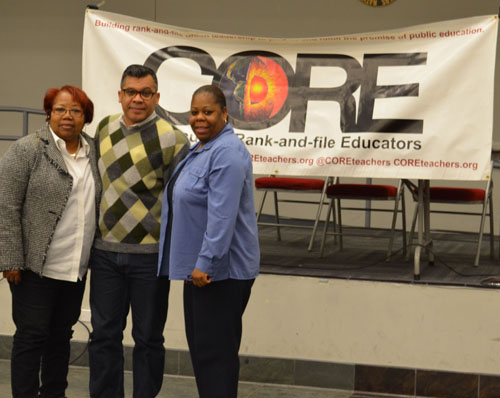 Three of the seven PSRP candidates for the various executive board offices slated by CORE were present at the meeting at the time of the above photograph. Substance photo by George N. Schmidt.The duties of those nominated were described as the nominations were read. "Functional vice presidents" are elected on the basis of one for every thousand union members in a particular group, or any part thereof. Based on the number of elementary teachers in the union as of January 1, 2013 (14,552), there were 15 elementary teachers slated for "elementary functional vice president" on the CORE slate. During the meeting, Caref reminded the slated candidates that each of the functional groups also has a committee that meets monthly to try and bring resolutions and reports to the union regarding the problems faced by that group.
Three of the seven PSRP candidates for the various executive board offices slated by CORE were present at the meeting at the time of the above photograph. Substance photo by George N. Schmidt.The duties of those nominated were described as the nominations were read. "Functional vice presidents" are elected on the basis of one for every thousand union members in a particular group, or any part thereof. Based on the number of elementary teachers in the union as of January 1, 2013 (14,552), there were 15 elementary teachers slated for "elementary functional vice president" on the CORE slate. During the meeting, Caref reminded the slated candidates that each of the functional groups also has a committee that meets monthly to try and bring resolutions and reports to the union regarding the problems faced by that group.
The complex democracy within the CTU requires that the various non-teaching groups represented by the union have elected functional vice presidents. For more than 20 years, the main division of the PSRP groups were between "Teacher Aides" and "Clerks." After the passage of the Amendatory Act of 1995, CPS was ordered by state law to abolish what had been called the "career service" positions and to privatize as many of the school system's non teaching jobs as possible. Although the first privatizations were aimed at lunchroom workers and school custodians (whose unionized ranks were decimated by privatization, to the detriment of their communities), the policy continued into the ranks of the CTU (which during the years the UPC ran the union ignored the attacks). By 2013, the functional groups electing functional vice presidents were School Clerks, Teacher Assistants (the group of which includes several job titles), School Community Reps (and other groups), Library Assistants (also expanded), and Audio-Visual Technicians. 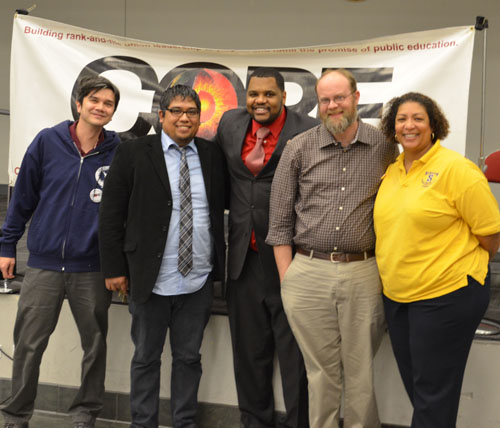 The CORE candidates for the "high school functional vice president" seats in the May 17, 2013 election. Functional vice presidents represent the members of the union on the union executive board, at the ratio of one functional VP for every 1,000 members in the group. The largest functional groups in the union are elementary teachers (representing more than 14,000 elementary teachers in the CTU) and high school teachers (representing more than 5,000 high school CTU teacher members). Left to right above: Xian Barrett, David Hernandez, Terrell Burgess, and Valerie Collins. Substance photo by George N. Schmidt.The second largest functional group consists of high school teachers, who currently elect six functional vice presidents, based on a membership (January 1, 2013) of 5,752.
The CORE candidates for the "high school functional vice president" seats in the May 17, 2013 election. Functional vice presidents represent the members of the union on the union executive board, at the ratio of one functional VP for every 1,000 members in the group. The largest functional groups in the union are elementary teachers (representing more than 14,000 elementary teachers in the CTU) and high school teachers (representing more than 5,000 high school CTU teacher members). Left to right above: Xian Barrett, David Hernandez, Terrell Burgess, and Valerie Collins. Substance photo by George N. Schmidt.The second largest functional group consists of high school teachers, who currently elect six functional vice presidents, based on a membership (January 1, 2013) of 5,752.
Teachers assistants, school clerks and the other functional groups also elect executive board members so that all of the groups in the union are represented at all levels. The only group that functions differently is the Retired Teachers group, which only elects one functional vice president, at a separate mail election held after the general election. No candidate for the retiree functional vice president slot was nominated on January 28.
The actual number of functional group candidates will not be known for certain until the February House of Delegates meeting, but CORE has nominated candidates for each of the groups, as well as four the four executive officers. While many of the candidates are incumbents, a large number are new to CORE, having joined within the past two years, after the election that put Karen Lewis and CORE into power at the union as of July 1, 2010.
The nominations of the CORE candidates is only the first step in a long and complex nominating process that will not end until April. In February and most of March, candidates circulate nominating petitions. Traditionally, CTU candidates run on "caucus" slates. A "caucus" in the CTU is basically an organized political party. In the 2010 election, there were originally five slates. That was reduced to a runoff (CTU elections require a majority, not just a plurality) between CORE (led by Karen Lewis) and the incumbent United Progressive Caucus (led at the time by Marilyn Stewart). In the original five-way election in May 2010, Stewart's caucus came in first, but did not have a majority, and Lewis's CORE caucus came in second. In the runoff, CORE defeated UPC decisively.
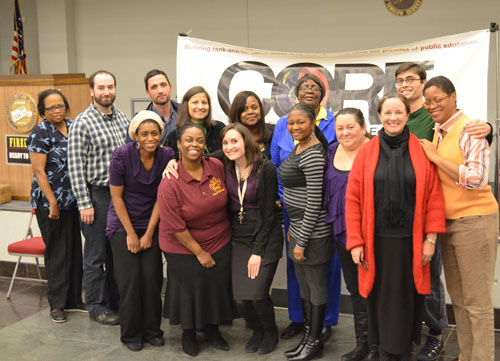 Elementary teachers in Chicago's real public schools teach children from pre-kindergarten through eighth grade. Above, the CORE candidates for the executive board positions of "Elementary Functional Vice President" in the May 17, election. Substance photo by Nate Goldbaum.Substance does not know how many caucuses will field slates for the 2013 election. Deadlines for obtaining and nominating petitions were approved at the January meeting of the union's House of Delegates, and the actual final slates will not be known until early April, when the eligibility of the candidates has been verified.
Elementary teachers in Chicago's real public schools teach children from pre-kindergarten through eighth grade. Above, the CORE candidates for the executive board positions of "Elementary Functional Vice President" in the May 17, election. Substance photo by Nate Goldbaum.Substance does not know how many caucuses will field slates for the 2013 election. Deadlines for obtaining and nominating petitions were approved at the January meeting of the union's House of Delegates, and the actual final slates will not be known until early April, when the eligibility of the candidates has been verified.
Since the 1960s, caucuses have been one of the most important expressions of democracy in the third largest (after New York City and Los Angeles) local of the 1.5 million member American Federation of Teachers (AFT). Although the CTU consolidated a number of groups that had existed prior to the Great Depression, it wasn't until 1936 that the union became its present self, consisting of high school and elementary teachers and a large number of others who work in Chicago's public schools. During its first 30 years, the union did not have written contracts, but by the mid-1960s written contracts -- and strikes to improve them -- had begun.
During the 1960s, when this reporter first became a CTU members (when I began teaching at Crispus Attucks Elementary School in 1969), the caucuses within the union were both political caucuses (those that ran candidates) and special issue and interest group caucuses (such as "Teachers for Integrated Schools" and the CTU Black Caucus, which for a time was part of the massive movement against racial segregation under the auspices of a group called COCO, the Coordinating Council of Community Organizations). 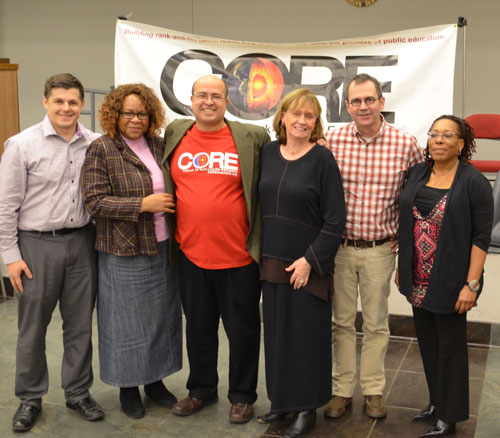 Candidates for trustees of the CTU lined up after their nominations as CORE candidates were approved at the January 28, 2013 CORE meeting. Left to right, Brian Halberg, Lois Ashford, Al Ramirez, Bernie Eshoo, Curt Maslanka, and Tammie Vinson. Substance photo by George N. Schmidt.By the late 1960s, the political caucuses within the union were the "Independent Caucus," the "Teachers Action Caucus," and the Progressive Caucus. In 1972, most of the members of the three groups united to form what became the "United Progressive Caucus" (UPC), which led the union through most of the next 40 years. During those 40 years, the UPC leadership was challenged electorally by groups ranging from CRAFT (Concerned Rank and File Teachers) in the 1980 election to "TAC II" in 1984 and 1988 (disclosure: this reporter headed the TAC II slate in 1984 and 1988) and other groups. By the mid-1990s, PACT (Pr-Active Chicago Teachers and School Workers) was founded and began running for office, winning the high school vice presidency seats in 1998 and sweeping into office at the top in 2001. From 2001 to 2004, Deborah Lynch, who headed the PACT slate and caucus, was CTU president. But a resurgent UPC unseated Lynch in the May and June 2004 elections, bringing the UPC back into power with Marilyn Stewart as President.
Candidates for trustees of the CTU lined up after their nominations as CORE candidates were approved at the January 28, 2013 CORE meeting. Left to right, Brian Halberg, Lois Ashford, Al Ramirez, Bernie Eshoo, Curt Maslanka, and Tammie Vinson. Substance photo by George N. Schmidt.By the late 1960s, the political caucuses within the union were the "Independent Caucus," the "Teachers Action Caucus," and the Progressive Caucus. In 1972, most of the members of the three groups united to form what became the "United Progressive Caucus" (UPC), which led the union through most of the next 40 years. During those 40 years, the UPC leadership was challenged electorally by groups ranging from CRAFT (Concerned Rank and File Teachers) in the 1980 election to "TAC II" in 1984 and 1988 (disclosure: this reporter headed the TAC II slate in 1984 and 1988) and other groups. By the mid-1990s, PACT (Pr-Active Chicago Teachers and School Workers) was founded and began running for office, winning the high school vice presidency seats in 1998 and sweeping into office at the top in 2001. From 2001 to 2004, Deborah Lynch, who headed the PACT slate and caucus, was CTU president. But a resurgent UPC unseated Lynch in the May and June 2004 elections, bringing the UPC back into power with Marilyn Stewart as President.
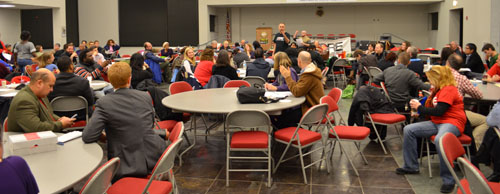 John Kugler (center rear) speaks to the January 28, 2013 CORE meeting of more than 100 teachers and other union members at the Letter Carriers union hall in Chicago. The meeting, which was the largest regular meeting in the history of the caucus, nominated the candidates for all leading Chicago Teachers Union posts for the May 17 union election. Substance photo by George N. Schmidt.The six years during which Marilyn Stewart served as CTU President and the UPC ruled the union saw the greatest attack on the city's public schools in history. During the time Arne Duncan was Chief Executive Officer of CPS (2001 - 2009), the program called "Renaissance 2010" pushed to close the city's real public schools and replace them with charter schools. The charters, supported by Duncan, the media, and Mayor Richard M. Daley, declared themselves successes even before they had opened their doors. They were given resources regularly by the CPS "Office of New Schools" (which for a time was headed by Josh Edelmen, whose brother Jonah Edleman heads the anti union corporate school reform group called "Stand for Children."
John Kugler (center rear) speaks to the January 28, 2013 CORE meeting of more than 100 teachers and other union members at the Letter Carriers union hall in Chicago. The meeting, which was the largest regular meeting in the history of the caucus, nominated the candidates for all leading Chicago Teachers Union posts for the May 17 union election. Substance photo by George N. Schmidt.The six years during which Marilyn Stewart served as CTU President and the UPC ruled the union saw the greatest attack on the city's public schools in history. During the time Arne Duncan was Chief Executive Officer of CPS (2001 - 2009), the program called "Renaissance 2010" pushed to close the city's real public schools and replace them with charter schools. The charters, supported by Duncan, the media, and Mayor Richard M. Daley, declared themselves successes even before they had opened their doors. They were given resources regularly by the CPS "Office of New Schools" (which for a time was headed by Josh Edelmen, whose brother Jonah Edleman heads the anti union corporate school reform group called "Stand for Children."
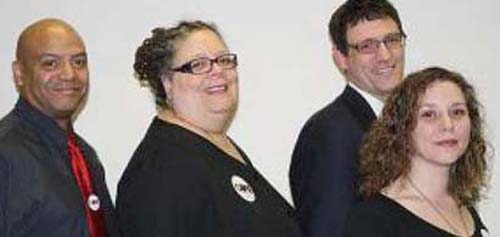 Nominated to lead the Chicago Teachers Union for another three year term by CORE on January 28, 2013, were, left to right, Recording Secretary Michael Brunson, President Karen Lewis, Vice President Jesse Sharkey, and Financial Secretary Kristine Mayle. In addition to the executive board and officer candidates slated at the January 28 meeting, CORE will run 150 candidates for the convention delegates to the conventions of the American Federation of Teachers and the Illinois Federation of Teachers. Both conventions are scheduled to be held in 2014. One executive board position, retired teacher functional vice president, is not elected on May 17 but by mail ballot after the June Retiree luncheon CORE announced that the AFT-IFT slate and the functional vice president for retirees would be slated at a later date.
Nominated to lead the Chicago Teachers Union for another three year term by CORE on January 28, 2013, were, left to right, Recording Secretary Michael Brunson, President Karen Lewis, Vice President Jesse Sharkey, and Financial Secretary Kristine Mayle. In addition to the executive board and officer candidates slated at the January 28 meeting, CORE will run 150 candidates for the convention delegates to the conventions of the American Federation of Teachers and the Illinois Federation of Teachers. Both conventions are scheduled to be held in 2014. One executive board position, retired teacher functional vice president, is not elected on May 17 but by mail ballot after the June Retiree luncheon CORE announced that the AFT-IFT slate and the functional vice president for retirees would be slated at a later date.
Voters in the May 17 union election will be voting on three ballots. Each functional group has a special ballot, listing the citywide candidates and then the candidate or candidates for functional vice president from each caucus, or independents who qualify. Voters also vote on separate ballots for delegates to the AFT convention and for alternate delegates to the convention. Under the rules, several groups of voters who do not work out of any particular school will be voting by mail ballot.
The ballot tabulation will be done by the American Arbitration Association, which has handled this job for the CTU for several elections. The complexity of the ballots and the need to keep complete and accurate records of the votes has led the union to outsource this work. AAA utilizes special state of the art scanner equipment which maintains the complete digital record of all the ballots. The Rules-Elections Committee will supervise the election on behalf of the union, although members of the committee who are also candidates are restricted in their presence on election night.


By: Jay Rehak
Great slate!
Looks like a great slate of teachers and educational support personnel. I look forward to casting my vote on May 17th!